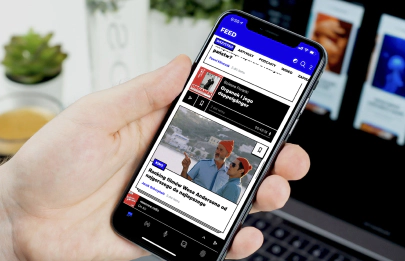3 September 2024 (updated: 3 September 2024)
Native vs Cross-Platform App Development: Which is Right for Your Business
Chapters

In the ever-evolving world of mobile technology, businesses face a crucial decision when it comes to mobile app development: native vs cross-platform app development.
Both mobile app development approaches offer unique advantages and potential pitfalls that can significantly impact the success of your project. Native development involves creating separate apps for each operating system, such as iOS and Android, while cross-platform development allows for a single codebase to be used across multiple platforms. In this article, you'll learn about the key differences, benefits, and challenges of native vs cross-platform app development, helping you determine which path is best suited for your business needs.
Introduction to app development
What is native app development?
Native mobile app development involves creating software specifically for a particular operating system, such as iOS or Android. Each app is built using the platform’s preferred programming languages and tools—Swift or Objective-C for iOS and Java or Kotlin for Android. This approach ensures that the app can fully leverage the device’s hardware and features, such as the camera, GPS, and accelerometer, to deliver a highly optimised user experience.
Although native apps often offer superior performance and a more seamless experience, they require separate development efforts for each platform. This can lead to higher costs and longer development times. However, for businesses that prioritise quality, speed, and user experience, native app development may be the preferable choice.
What is cross-platform app development?
Cross-platform app development allows developers to create a single codebase that runs on multiple operating systems, such as iOS and Android. Tools like Flutter, React Native, and Xamarin provide frameworks for building these cross platform mobile apps, enabling businesses to reach a broader audience without the need for separate development projects for each platform.
This approach can be more cost-effective and faster to deploy, given that a unified codebase reduces the time and resources required for development and maintenance. However, cross-platform apps might not fully utilise all the native features of each operating system, potentially impacting performance and user experience. Nonetheless, for businesses aiming to achieve a wider market reach quickly and efficiently, cross-platform app development presents a compelling option.
Importance of choosing the right approach
Selecting the right approach between native and cross-platform app development is crucial for the success of your mobile project. The decision can affect not only the development timeline and budget but also the overall user experience and app performance. Native apps generally provide a smoother, more responsive experience, which can be vital for user retention and satisfaction. Conversely, cross-platform apps can accelerate time-to-market and reduce costs, allowing businesses to launch their products more swiftly.
Moreover, the choice can influence future updates and scalability. Native apps may require more effort to update across different platforms, whereas cross-platform apps benefit from a single codebase but might face limitations in leveraging new platform-specific features. Therefore, weighing the pros and cons of each approach based on your business goals, target audience, and resource availability is essential for making an informed decision.
Benefits of native app development
Superior performance
One of the most significant advantages of native app development is its superior performance. Native app developers build apps specifically for a particular operating system, using platform-optimised programming languages and tools. This allows them to run more efficiently and take full advantage of the device’s hardware capabilities. As a result, users experience faster load times, smoother interactions, and a more responsive interface.
Moreover, native apps can handle complex tasks and animations more effectively, providing a seamless user experience even under demanding conditions. This performance boost is particularly crucial for applications that require high processing power, such as gaming, augmented reality, or intensive data operations. For businesses where performance and user satisfaction are paramount, the investment in native app development can yield significant returns.
Enhanced user experience
Native app development offers an enhanced user experience due to its alignment with the specific design guidelines and standards of each operating system. This means that iOS apps will look and feel as Apple intended, and Android apps will match Google's design principles. This consistency provides users with a familiar and intuitive interface, boosting overall satisfaction and ease of use.
Additionally, native apps can access and utilise the latest features and updates of the operating system as soon as they are available. This ensures that users benefit from the latest advancements in technology, security, and performance. The ability to seamlessly integrate with device-specific functionalities, such as gestures, camera, and notifications, further enriches the user experience. For businesses aiming to deliver a top-notch, polished app, native development is often the superior choice.
Better security
Native app development provides better security due to its close integration with the operating system's built-in security features. Each platform, be it iOS or Android, offers robust security protocols that can be fully leveraged by native apps. This includes data encryption, secure authentication methods, and regular security updates, which help protect sensitive user information and ensure compliance with industry standards.
Furthermore, native apps can more effectively utilise advanced security features, such as biometric authentication (e.g., fingerprint or facial recognition) and hardware-backed key management. These capabilities offer an added layer of protection against potential threats and vulnerabilities. For businesses handling confidential or sensitive data, the enhanced security offered by native app development can be a critical factor in safeguarding user trust and maintaining regulatory compliance.
Advantages of cross-platform app development
Cost efficiency
One of the primary advantages of cross-platform app development is its cost efficiency across Android and iOS platforms. By using a single codebase for multiple operating systems, businesses can significantly reduce the time and resources required for development. This unified approach eliminates the need for separate teams and projects for iOS and Android, which can lead to substantial savings in development and maintenance costs.
Moreover, cross-platform frameworks like Flutter and React Native offer reusable components and pre-built modules, further accelerating the development process and reducing expenses. For startups and small to medium-sized enterprises with limited budgets, this cost-effective strategy allows them to allocate resources more efficiently while still reaching a wide audience. By streamlining the development process, cross-platform app development enables businesses to bring their products to market faster without compromising on quality.
Faster time to market
Cross-platform app development offers a faster time to market compared to native development. With a single codebase that works across multiple operating systems, developers can simultaneously build and deploy apps for both iOS and Android. This streamlined process can significantly cut down the overall development timeline, enabling businesses to launch their apps more quickly.
Frameworks like Flutter and React Native provide a range of pre-built modules and libraries, which further speed up the development process. These tools simplify many complex tasks, allowing developers to focus on custom features and user experience. For businesses operating in fast-paced markets or aiming to capitalise on emerging trends, the ability to deliver a product swiftly can be a crucial competitive advantage. By reducing time to market, cross-platform development helps businesses stay ahead of the curve and respond more rapidly to user demands and market changes.
Easier maintenance
Cross-platform app development simplifies maintenance by leveraging a single codebase for multiple platforms. This unified approach means that updates, bug fixes, and feature enhancements only need to be implemented once, rather than separately for each operating system. Consequently, developers can address issues and roll out improvements more quickly and efficiently.
Additionally, cross-platform frameworks like React Native and Flutter offer hot-reloading features, allowing developers to see changes in real-time without restarting the entire application. This accelerates the debugging process and ensures that updates are deployed faster. For businesses, easier maintenance translates to lower ongoing costs and less downtime, ensuring that the app remains up-to-date with user expectations and technological advancements. By simplifying the maintenance process, cross-platform development allows businesses to focus more on innovation and user engagement rather than managing multiple codebases.
Key considerations for your business
Target audience and market reach
When deciding between native and cross-platform app development, understanding your target audience and market reach is crucial. Native apps can offer a more tailored experience, leveraging specific features and design elements unique to each operating system. This is particularly important if your user base heavily favours one platform over another, such as iOS in certain regions or Android in others.
On the other hand, cross-platform development allows you to reach a broader audience more quickly. By deploying your app on multiple platforms simultaneously, you can maximise market penetration and cater to a diverse user base. This approach is especially beneficial for businesses looking to establish a presence in various markets without significant delays.
Balancing the need for customised user experiences with the goal of extensive market reach will help you determine the most appropriate development strategy for your business. Consider your audience's preferences and behaviours to make an informed decision.
Budget constraints
Budget constraints are a significant factor when choosing between native and cross-platform app development. Native app development often requires separate teams and projects for iOS and Android, leading to higher initial costs. Each platform's unique development process can also extend timelines, further increasing expenses.
In contrast, cross-platform development offers a more budget-friendly option. By utilising a single codebase, businesses can save on development and maintenance costs. This approach reduces the need for multiple teams and allows for faster deployment, making it an attractive choice for startups and small businesses with limited resources.
However, it's essential to weigh these cost savings against potential compromises in performance and user experience. While cross-platform apps can be more economical, they may not fully exploit the native features and capabilities of each platform. Balancing your budget constraints with your app's performance and user experience goals will help you make a well-informed decision.
Project timeline
The project timeline is a critical consideration when choosing between native and cross-platform app development. Native development typically involves creating separate codebases for iOS and Android, which can lead to longer development cycles. This dual-track approach requires more time for coding, testing, and optimisation, potentially delaying the app's launch.
Conversely, cross-platform development offers a more streamlined timeline. With a single codebase that works across multiple platforms, developers can expedite the development process. Frameworks like Flutter and React Native provide tools and libraries that simplify many tasks, allowing for quicker iterations and faster deployment. This accelerated timeline is particularly advantageous for businesses looking to enter the market rapidly or respond to emerging trends.
However, it's essential to ensure that the speed of development does not compromise the app's quality and performance. Balancing the project timeline with the need for a polished, feature-rich app will help you achieve your business objectives effectively.
Making the right decision
Assessing your business needs
Assessing your business needs is the first step in making the right decision between native and cross-platform app development. Start by identifying your primary goals: Are you prioritising performance and user experience, or is a broad market reach more critical? Consider the specific features your app requires and how integral they are to your business model.
Analyse your target audience's preferences and behaviours. If your users predominantly favour one platform, native development might be the better choice. However, if your audience is diverse, a cross-platform approach can provide a more inclusive solution.
Evaluate your budget and resources. Native development generally demands higher upfront costs and longer timelines, while cross-platform development can offer cost and time efficiencies. Finally, consider the long-term maintenance and scalability of your app. By thoroughly assessing these aspects, you can align your development strategy with your business objectives and make a well-informed decision.
Weighing pros and cons
Weighing the pros and cons of native vs cross-platform app development is crucial for making an informed decision. Native development offers superior performance, enhanced user experience, and better security. However, it comes with higher costs and longer development timelines, as separate codebases are required for iOS and Android.
On the other hand, cross-platform development provides cost efficiency, faster time to market, and easier maintenance due to a single codebase. This approach allows businesses to reach a broader audience quickly. However, it may come with compromises in performance and limited access to platform-specific features.
Consider the specific needs of your project, including budget, timeline, and target audience. Native development might be more suitable for apps requiring high performance and user engagement, while cross-platform development can be ideal for businesses looking to maximise reach and minimise costs. By carefully evaluating these factors, you can choose the approach that best aligns with your business goals.
Summing up
When deciding between native and cross-platform app development, prioritise your business objectives and resource availability. If your primary goal is to deliver a high-performance app with an exceptional user experience, native development is often the best choice. This approach allows you to fully utilise the unique features and capabilities of each operating system, ensuring a seamless and responsive user experience.
However, if budget constraints and a shorter time-to-market are more pressing concerns, cross-platform development can be a more practical solution. This method allows you to deploy your app across multiple platforms with a single codebase, saving time and resources.
Ultimately, the right decision hinges on a careful evaluation of your specific needs, target audience, and long-term goals. Consider consulting with experienced developers to gain additional insights and ensure that your chosen approach aligns with your overall business strategy. By making an informed decision, you can maximise the potential success of your mobile app project.
Check out also:
- How to Improve React Native Performance? - Learn about tips and tricks for optimizing React Native app performance.
- React Native vs. Native App Development: Pros and Cons in 2024 - Establish your app’s priorities to benefit from the used technology.






